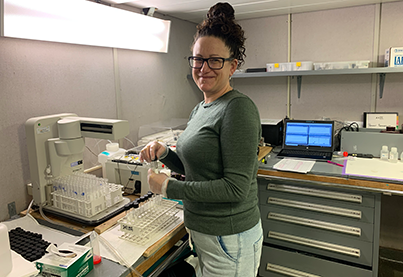Ashley Arroyo
October 6, 2022
An important group of chemical parameters that are analyzed onboard the Louis are dissolved inorganic nutrients (i.e., nitrate, phosphate, and silicate). Primary production (the creation of organic material through photosynthesis) requires carbon dioxide, water, sunlight, and inorganic nutrients. Measuring these nutrients throughout the water column gives insight into biological processes and ecosystems in the Arctic Ocean. As primary production occurs, the nutrients are used up; Arctic Ocean primary productivity is generally limited by nutrients, resulting in extremely low nutrient concentrations in the surface layer (generally from the surface to about 40m depth). The organic matter that is produced then begins to sink, decompose, and break up back into its inorganic constituents (i.e., dissolved inorganic carbon and nutrients), resulting nutrient concentrations that increase with depth in the upper water column. In the deeper waters (more than around 500m depth), nutrient concentrations are more uniform with depth because the breakdown of organic matter is slower than in the upper waters.
Beyond the information that we can gain about biology of the Arctic Ocean, nutrients can also be used to trace the origin of different waters. For example, since the Canada Basin has water layers that come from both the Atlantic and Pacific oceans, the amount of nitrate compared to the amount of phosphate (that is, the nitrate-phosphate ratio, or N:P) can be used to differentiate between the layers. The Pacific water in the Arctic Ocean tends to have low nitrate concentrations, resulting in a low N:P ratio, whereas the Atlantic water has a higher N:P ratio. A determination of these ratios can be coupled with the knowledge of other water mass tracers to determine the sources of different water masses in the Arctic Ocean.
The inorganic nutrients are analyzed onboard by Sarah-Ann Quesnel from the Institute of Ocean Sciences (IOS). The water samples for the nutrients from the Niskin bottles on the CTD rosette are collected in pairs: one set was analyzed onboard within 12 hours of collection, and the other was stored at -20°C in the case that further analysis was needed after the conclusion of the expedition. The nutrients are analyzed using an auto-analyzer (AA3), which is a machine that determines the amount of dissolved inorganic nutrients contained in water samples. The water samples are mixed with reagents, and turn a certain color based on the nutrient concentration in each sample. The resulting liquid is then run through an LED optical sensor called a colorimeter, and the nutrient concentrations are determined.

